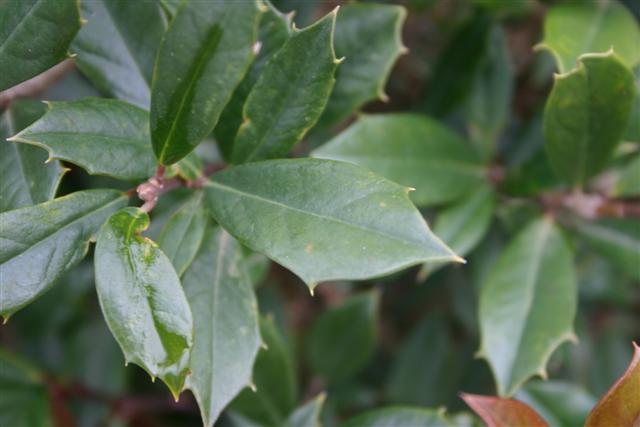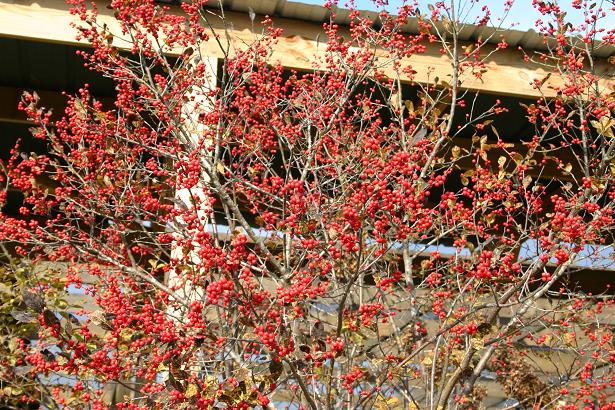
Or help "drought-scaping?"
Check out our Design Services.
We're also offering a 10% discount
for December & January Appointments

|
Need design help? Or help "drought-scaping?" Check out our Design Services. We're also offering a 10% discount for December & January Appointments |
| Burford Holly |
| Cultivar & Size | Leaf Structure | Comments |
|
'Burfordii' (Burford) 15x10 |
Bright glossy green usually with a single terminal spine | Female, but has the ability to bear fruit parthenocarpically (without pollination) |
|
'Carissa' 4x6 |
Light green curved usually with a single terminal spine | Female, but usually no fruit. Can revert easily to spiny 'Rotunda' form |
|
'Dwarf Burford' 6x5 |
Dark green usually with a single terminal spine | Less fruit than 'Burfordii' |
|
'Needlepoint' 12x8 |
Shiny dark green usually with a single terminal spine | Female, good fruit set with pollination |
|
'Rotunda' 4x8 |
Shiny green with very nasty spines | Female, but little if any fruit |

|

|

|
| Burford Holly Leaf | Carissa Holly Leaf | Rotunda Holly Leaf |
| Cultivar & Size | Leaf Structure | Comments |
|
'Compacta' 4x4 |
Dark green toothed leaves with purple stems | Gender unknown since this name may represent more than one clone |
|
'Fastigiata' 8x3 |
Thick, dark green | Gender unknown since this name may represent more than one clone |
|
'Green Lustre' 6x10 |
Dark green lustrous and thick | Female |
|
'Helleri' 5x5 |
Leaves very similar to Compacta | Female |
|
'Sky Pencil' 8x2 |
Dark green | Female |

|

|

|
| Compacta Holly Leaf | Compacta Holly Habit | Sky Pencil Holly Habit |
| Name | Size | Comments |
|
Foster Holly Ilex x attenuata 'Fosteri' |
30x15 | Actually a group of hybrids comprised of male and female (red fruit) plants. |
|
Savannah Holly Ilex x attenuata 'Savannah' |
30x15 | Female that has short spines and heavy red fruit set with pollination |
|
Emily Bruner Holly Ilex x 'Emily Bruner' |
20x10 | Female with dark green leaves with a single terminal spine and heavy red fruit set with pollination |
|
Nellie R. Stevens Holly Ilex x 'Nellie R. Stevens' |
20x12 | Female with dark green leaves with 7+/- spines and heavy red fruit set (some parthenocarpically) |

|

|
| Foster Holly Leaf | Savannah Holly Bark |
| Name | Cultivars | Comments |
|
Inkberry Ilex glabra |
'Shamrock', 'Densa', 'Compacta', etc. | Evergreen with dark blue (sometimes white) fruit on females |
|
American Holly Ilex opaca |
numerous | Evergreen with bright red fruit on females; can grow to be a 50-foot tree |
|
Yaupon Holly Ilex vomitoria |
'Nana', 'Pendula', 'Dodd's Yellow', etc. | Evergreen with bright red (sometimes golden) fruit on females |
|
Winterberry Ilex verticillata |
'Berry Nice', 'Red Sprite', 'Winter Red', 'Southern Gentleman', etc. | Deciduous holly with bright red fruit on females; good wetland plant |
|
Possumhaw Ilex decidua |
'Byer's Golden', 'Red Cascade', etc. | Deciduous holly with bright red (sometimes golden) fruit on females |

|

|

|
| Inkberry Holly Leaf | American Holly Habit | Winterberry Fruit |